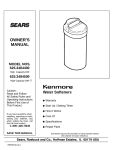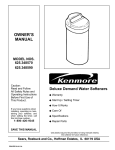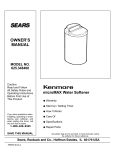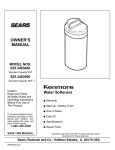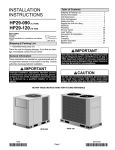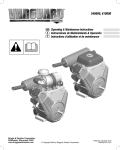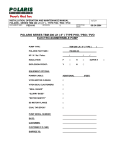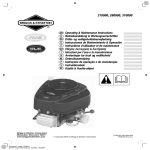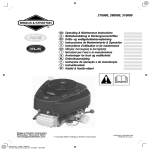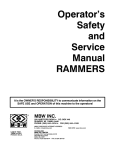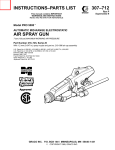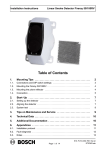Download Kenmore 625.34842 User's Manual
Transcript
OWNER’S MANUAL MODEL NO. 625.348420 Caution: Read and Follow All Safety Rules and Operating Instructions Before First Use of This Product. Demand Special Edition Water Softener ◆ Warranty ◆ Start Up / Setting Timer If you have questions when installing, operating or maintaining your softener, and when setting the timer, call this toll–free number... 1–800–426–9345 ◆ How It Works ◆ Care Of ◆ Specifications ◆ Repair Parts SAVE THIS MANUAL Use plastic bag and tie provided, to hang manuals nearby the softener for future reference. PRINTED IN U.S.A. WARRANTY SEARS RESIDENTIAL WATER SOFTENER FULL ONE YEAR WARRANTY ON WATER SOFTENER For one year from the date of purchase, when this water softener is installed and maintained in accordance with our instructions, Sears will repair, free of charge, defects in material or workmanship in this water softener. FULL TEN YEAR WARRANTY AGAINST LEAKS For ten years from the date of purchase, Sears will furnish and install a new current model water softener tank or salt storage drum, free of charge, if either the tank or drum develop a leak. TO OBTAIN WARRANTY SERVICE, SIMPLY CONTACT THE NEAREST SEARS SERVICE CENTER THROUGHOUT THE UNITED STATES. This warranty applies only while this product is in use in the United States. This warranty gives you specific legal rights, and you may have other rights which vary from state to state. Sears, Roebuck and Co., D/817 WA, Hoffman Estates, IL 60179 &" $! &" $! ! & ! ! ! &" $ ! "!& !! & "!' ! SEARS INSTALLATION POLICY !! & ! $ $! & ! ! ! "! !! & $! $ "! " ! !! " !! & " ! ! !& ! " !& SEARS INSTALLATION WARRANTY ! ! & $!& %! ! &" ! ## $ $!& ( !# ! ! ! ! " ! $ & !! # "!& $! & $ " ! &" " " "! ! ! ! ! ! ! &" FACTS AND FIGURES TO KEEP Fill in the blanks below and keep this book in a safe place so you always have these facts. Water Softener Model No.† Serial Number Date Installed Water Hardness Grains Per Gallon Iron Content Parts Per Million *pH Taste And/Or Odor Water Pressure Pounds/Square Inch Water Flow Rate Gallons Per Minute † The model number is on the rating decal, located on the rim, under the salt hole cover. 2 TABLE OF CONTENTS PAGE NO. SECTION 1 A. B. C. D. E. SAFETY GUIDES CHECK LIST OF STEP-BY-STEP GUIDES TO INSTALL PROGRAM THE TIMER SANITIZING THE WATER SOFTENER FILL THE STORAGE TANK WITH SALT SECTION 2 A. B. A. 14 15 16 17 OTHER THINGS TO KNOW DIMENSIONS/SPECIFICATIONS SECTION 5 10 11-13 CARE OF YOUR SOFTENER SALT: REFILLING STORAGE TANK, SALT BRIDGE KEEPING THE WATER SOFTENER CLEAN KEEP THE SOFTENER FROM FREEZING HELPFUL HINTS CHECKLIST SECTION 4 4 5 6-7 8 9 HOW YOUR WATER SOFTENER WORKS FACE PLATE TIMER FEATURES SOFT WATER SERVICE AND REGENERATION SECTION 3 A. B. C. D. SOFTENER START UP 18 SERVICE TECH INFORMATION A. TROUBLESHOOTING B. ROTARY VALVE SERVICE C. WATER FLOW THROUGH THE SOFTENER VALVE 19-22 23 24-26 SECTION 6 29-31 REPAIR PARTS 3 SECTION 1 1A. WATER SOFTENER START-UP SAFETY GUIDES ▲ Read all steps, guides and rules carefully before installing and using your new water softener. Follow all steps exactly to correctly install. Failure to follow them could cause personal injury or property damage. Reading this book will also help you to get all of the benefits from your water softener. ▲ Your water softener will remove hardness minerals and “clear water” iron from water, up to the limits shown on page 18. It will not remove other types of iron, acids, tastes and odors, etc. It will not purify polluted water or make it safe to drink. ▲ Protect the softener and piping from freezing. Damage from freezing voids the softener warranty. See page 16. CAUTIONS PLEASE READ AND COMPLY WITH THE FOLLOWING GUIDES TO PREVENT DAMAGE TO THE SOFTENER OR OTHER PROPERTY, PERSONAL INJURY, OR POSSIBLE FATAL SHOCK. ▲ THIS SOFTENER WORKS ON 24 VOLTS ONLY. BE SURE TO USE THE TRANSFORMER INCLUDED, AND PLUG IT INTO A 120V OUTLET. ▲ Unplug the transformer right away if the power cable should become damaged or frayed. Make repairs before plugging back into the power outlet. ▲ Always unplug the softener from electrical power before removing outer valve covers. 4 SECTION 1 1B. WATER SOFTENER START-UP CHECK LIST OF ALL STEP-BY-STEP GUIDES TO INSTALL Refer to the Installation Manual, part no. 7159931, for stepĆbyĆstep guides. To be sure you have done all the steps to install the softener, read the following list. Page numbers referred to are in the ✔ Is the house going the softener valve ? Trace piping to be sure. See pages 10 and 11. ✔ Is the plumbing bypass valve (or 3 valves) set for soft water ? See page 18. ✔ Is the valve drain hose connected to the drain fitĆ ting the right way? Does the drain hose run to the drain point without sharp bends or kinks that could stop or reduce water flow? See page 16. ✔ Is the softener power cable connected to the transformer, and is the transformer plugged into 120VĆ60Hz electrical outlet? See page 20. brass 3–valve Bypass Valves ✔ Be sure to restart the water heater. See page 20. plastic Water Heater NOTE: The state of Massachusetts requires a licensed plumber to perform the installation. 5 SECTION 1 WATER SOFTENER START-UP 1C. PROGRAM THE TIMER FIG. 1 display UP button DOWN button Sears Water Line for Customer Assistance 1–800–426–9345 Kenmore ON/OFFHOLD RECHARGE TONIGHT RECHARGE NOW Demand Water Softener SELECT SELECT button ON/OFF–HOLD button (Recharge Tonight–Now) reaches 1 using the DOWN button, or the highest hardness setting using the UP button. When the transformer is plugged in, the model code SR17 shows in the face plate display for a few seconds, followed by a test number (example: S3.0). After the test number, 12:00 AM begins to flash. PRESENT TIME and RECHARGE TONIGHT show at the bottom of the display. 1. SET PRESENT TIME OF DAY: NOTE: If the words PRESENT TIME do not show in the disĆ play, press the SELECT button (FIG. 1) until they do. ■ Press the UP/DOWN buttons to set the present time. Press UP to move the display ahead; press DOWN to move the time backward. NOTE: If SR - - is flashing in the display, press the UP button (FIG. 1) until SR17 shows. Then, press the SELECT button to display the flashing 12:00 AM. If other than SR17 shows, when the transformer is plugged in, please see page 17 to reset. If the present time is between noon and midnight, be sure PM shows. If the present time is between midnight and noon, be sure AM shows. SOUND BEEPER": A beeper" sounds while pressing buttons for timer setĆup. One beep signals a change in the face plate display. Repeated beeps means the timer will not accept a change from the button you have pressed, telling you to use another button. For example, in setting the hardness (step 2), the beeper sounds repeatedly when the display NOTE: Each press of the UP or DOWN buttons changes the time by 1 minute. Pressing and holding the buttons changes the time 32 minutes each second. 6 SECTION 1 1C. WATER SOFTENER START-UP PROGRAM THE TIMER 2. SET WATER HARDNESS NUMBER: 3. SET RECHARGE (REGENERATION) TIME: ■ Press the SELECT button once to display 15 (flashing) and HARDNESS. ■ Press the SELECT button once to display 2:00 AM (flashing) and RECHARGE TIME. The grains per gallon (gpg) hardĆ ness of your water supply is on your water analysis report. Be sure to enter water test results on page 2, for future reference. At the 2:00 AM RECHARGE TIME setting, the softener begins regenĆ eration (see pages 11 and 12) at 2:00 AM, ending no later than 4:00 AM. This is a good time in most households because water is not being used (see AUTOMATIC BYĆ PASS, page 13). NOTE: If your water supply contains iron, compensate for it by adding to the water hardness number. 2 ppm iron x 5 = 10 (times) If a different RECHARGE TIME setting would be better for your household, do the following. ■ Press the UP/DOWN buttons to set the desired RECHARGE starting hour. Be sure to observe the AMĆPM as you did when setting the time of day. 15 gpg hardness +10 25 HARDNESS NUMBER NOTE: Each press of the UP/DOWN buttons changes the display 1 hour. Continuous pressure on the UP or DOWN button changes the display twice each second. ■ Press the UP/DOWN buttons to set your water hardness number in the display. The DOWN button moves the display to 1. The UP button moves the display to the highest setting (see maximum setting for your model in the specifications). ■ to return the present time (steady) of day and RECHARGE TONIGHT in the display. NOTE: Each press of the UP/DOWN button changes the display by 1 between 1 and 25. Between 25 and the highest number, the display changes 5 at a time…25, 30, 35, etc. Continuous pressure on the UP or DOWN button changes the display twice each second. IF YOU NEED HELP PROGRAMMING THE TIMER, CALL TOLL FREE, NUMBER 1-800- 426- 9345. SEE PAGE 10 FOR OTHER FACE PLATE TIMER FEATURES. 7 SECTION 1 1D. WATER SOFTENER START-UP SANITIZING THE WATER SOFTENER Care is taken at the factory to keep your water softener clean and sanitary. Materials used to make the softener will not infect or contaminate your water supply, and will not cause bacteria to form or grow. However, during shipping, storage, installing and operating, bacteria could get into the softener. For this reason, sanitizing as follows is suggested① when installing. FIG. 2 ADD WATER Salt Hole Cover hose 1. The first time you sanitize your softener, be sure to do steps in the installation manual, and on pages 5, 6 and 7 of this manual first. 2. Lift the salt hole cover and use a pail or hose to fill the salt storage tank with at least 3 gallons of water. Brinewell Cover (remove and add about 3/4 oz. bleach) Brinewell 3. Remove the brinewell cover and pour about 3/4 ounce, or 1 to 2 tablespoons, of common 5.25% household bleach (Clorox, Linco, BoPeep, White Sail, Eagle, etc.) in the softener brinewell. Water, About 3 Gallons 4. Press the ON/OFFĆHOLD button and to start a recharge. This first recharge does several things. Ċ It draws the bleach into and through the softĆ ener to sanitize it. Ċ It fills the salt tank to the water level needed. Ċ It gets all the air out of the resin tank. Ċ It makes the resin bed (see page 11) ready for service. NOTES: This recharge takes about 2 hours. You can sanitize the softener salt in the storage tank. ① Recommended by the Water Quality Association. On some water supplies, the water softener may need periodic disinfecting. Sanitize with or without salt in the storage tank. 8 SECTION 1 1E. WATER SOFTENER START-UP FILL THE STORAGE TANK WITH SALT Brine (salt dissolved in water) is needed for each and every regeneration. The water for making brine is metered into the salt storage tank by the softener. However, you must keep the tank filled with salt. FIG. 3 ADD SALT Fill the tank with NUGGET or PELLET water softener salt. DO NOT use rock salts, as they have dirt and sediments that will stop the softener from working. Before filling, be sure the brinewell cover is in place on the top of the brinewell. Salt storage capacity is shown on page 18. NOTE: In humid areas, it is best to fill the storage tank halfĆfull, and to refill it more often. Salt bridging (see page 14) occurs more often when conditions are humid. Brinewell Cover Water softening salt with iron removing addiĆ tives Ċ Some salts have an additive to help the softener handle iron in the water supply. Although this additive may help to keep the softener resin clean, it may also release corrosive fumes that will weaken and shorten the life of some softener parts. Water softeners using sodium chloride for regeneration add sodium to the water. Persons who are on sodium restricted diets should consider the added sodium as part of their overall sodium intake. For example, if your water supply is 15 grains hard, you would have to drink 3 quarts of softened water to consume 335 milligrams of sodium. That is equivalent to eating 2Ć1/2 slices of white bread. Persons who are concerned about their drinking water should consider a Sears Drinking Water System that will remove or reduce in excess of 90% of the sodium and other drinking water contaminants. YOU HAVE NOW FINISHED THE WATER SOFTENER STARTĆUP. AFTER THE SANITIZING RECHARGE, ON PAGE 8, THE SOFTENER WILL BE GIVING YOU SOFT WATER. 9 SECTION 2 2A. HOW YOUR WATER SOFTENER WORKS FACE PLATE TIMER FEATURES EXTRA RECHARGE PROGRAM MEMORY If electrical power to the softener goes off, the time display is blank but the face plate timer keeps the correct time for about 6 hours. When electrical power comes on again, you have to reset the present time if the display is flashing. The HARDNESS and RECHARGE TIME never require resetting unless a change is desired. Sometimes, a manually started regeneration (reĆ charge) may be desired, or needed. Two examples are: -- You have used more water than usual (guests visiting) and you may run out of soft water before the next timer started regeneration. Even if the timer is incorrect after a long power outage, the softener works as it should to keep you water soft. However, regenerations may occur at the wrong time of day until you reset the timer to the correct time of day. -- You did not refill the softener with salt before it was gone. You can start a regeneration right away, or you can set the timer to regenerate at the next 2:00 AM (or other preset recharge time). Do the following. RECHARGE NOW ERROR CODE An error code could appear in the face plate display if a problem occurs in the softener electronics. If you see an error code instead of the time of day, please call you local Sears Service Department for service. ■ Press the ON/OFFĊHOLD button and RECHARGE NOW begins to flash in the display, and the softener enters the fill cycle of regeneration right away. This regeneration will last for about 2 hours. Then, you will have soft water again. RECHARGE TONIGHT ■ Press and release ( ) the ON/OFFĆHOLD butĆ ton. RECHARGE TONIGHT flashes in the display, and the softener begins regeneration at the next preset recharge time. If you decide to cancel the regenĆ eration before it has started, press and release the ON/OFFĆHOLD button once more to turn off the flashing RECHARGE TONIGHT. IF YOU NEED HELP ON THE USE OF THE TIMER FEATURES, CALL TOLL FREE, NUMBER 1-800- 426-9345. 10 SECTION 2 2B. HOW YOUR WATER SOFTENER WORKS SOFT WATER SERVICE AND REGENERATION SERVICE When the softener is giving you soft water, it is called Service". During service, hard water flows through the house main water pipe and into the softener. Inside of the softener resin tank is a bed made up of thousands of tiny, plastic resin beads (FIG. 4). As hard water passes through the bed, each bead attracts and holds the hardness minerals. This is called ionĆexchanging. It is much like a magnet attracting and holding metals. Water without the hardness minerals (soft water) flows out of the softener and into the house soft water pipes. REGENERATION FILL: Salt, dissolved in water, is called brine. Brine is needed to clean the hardness minerals from the resin beads. To make the brine, water flows into the salt storage area during the fill stage as shown in FIG. 5. Fill cycle length depends on how much soft water making capacity you have used since the last regeneration. As you use more water, fill time increases so more brine is made. The greater amount of brine cleans more hardness minerals from the resin bed. After a period of time, the resin beads become coated with hardness minerals and they have to be cleaned. This cleaning is called regeneration or recharge. Regeneration is started at 2:00 a.m. by the electronic timer (see page 13). It takes place in 5 stages or cycles. These are: 1 2 3 FILL BRINING BRINE RINSE 4 5 FIG. 5 WATER FLOW THROUGH THE SOFTENER IN FILL BACKWASH FAST RINSE soft water OUT FIG. 4 WATER FLOW THROUGH THE salt storage tank SOFTENER IN SERVICE soft water OUT salt storage tank (salt not shown) brine valve hard water IN ÌÌÌÌ ÌÌÌÌ ÌÌÌÌ ÌÌÌÌ ÌÌÌÌ ÌÌÌÌ ÌÌÌÌ ÏÏÏÏÏÏÏÏ ÌÌÌÌ ÏÏÏÏÏÏÏÏ ÌÌÌÌ brine valve ÌÌÌÌ ÌÌÌÌ ÌÌÌÌ ÌÌÌÌ ÌÌÌÌ ÏÏÏÏÏÏÏÏ ÌÌÌÌ ÏÏÏÏÏÏÏÏ ÌÌÌÌ ÏÏÏÏÏÏÏÏ ÌÌÌÌ ÏÏÏÏÏÏÏÏ ÌÌÌÌ ÏÏÏÏÏÏÏÏ ÌÌÌÌ fill water resin tank resin bed 11 hard water IN SECTION 2 2B. HOW YOUR WATER SOFTENER WORKS SOFT WATER SERVICE AND REGENERATION BRINING: During brining, the brine is moved from the salt storage area, into the resin tank. Inside the resin tank, brine cleans hardness minerals from the resin beads and they are discharged out the drain. How much brine is needed to clean the resin depends on: FIG. 7 WATER FLOW THROUGH THE SOFTENER IN BACKWASH hard water bypass OUT drain -- the amount of resin in the softener, -- how fast the brine goes through the bed. ÌÌÌ ÌÌÌ ÌÌÌ ÌÌÌ ÌÌÌ ÌÌÌ ÏÏÏÏÏÏ ÌÌÌ ÏÏÏÏÏÏ ÌÌÌ ÏÏÏÏÏÏ ÌÌÌ The nozzle and venturi (FIG. 6) make suction to move brine from the salt tank into the resin tank. They keep the brine flow down to a very slow rate to get the best resin cleaning with the least salt. BRINE RINSE: After all of the brine is sucked out of the salt tank, the brine valve closes. Water keeps flowing through the resin tank the same way it did during brining except the brine flow has stopped. Hardness minerals and brine flush from the resin tank to the drain. Brining and brine rinse together vary in length of time they take, relative to the fill cycle length. resin bed lifted and expanded FAST RINSE: Backwash is followed by a fast flow of water down through the resin tank. The fast flow packs the resin bed and gets it ready for return to service (FIG. 8). FIG. 6 WATER FLOW THROUGH THE After fast rinse, the softener returns to service. Hard water goes into the resin tank where the resin bed again takes out the hardness minerals. Soft water goes to the house soft water pipes. SOFTENER IN BRINING AND BRINE RINSE hard water bypass OUT nozzle & venturi hard water IN hard water IN FIG. 8 WATER FLOW THROUGH THE drain SOFTENER IN FAST RINSE ÌÌÌ ÌÌÌ ÌÌÌ ÌÌÌ ÌÌÌ ÏÏÏÏÏÏÏ Ì ÌÌÌ ÏÏÏÏÏÏÏ ÌÌÌ soft water OUT hard water IN drain brine valve ÌÌÌ ÌÌÌ ÌÌÌ ÌÌÌ ÌÌÌ ÌÌÌ ÏÏÏÏÏÏ ÌÌÌ ÏÏÏÏÏÏ ÌÌÌ brine BACKWASH: During backwash, water flows UP through the resin tank (FIG. 7) at a fast rate to flush iron minerals, dirt and sediments from the bed and to the drain. The bed lifts and expands for good cleaning. 12 SECTION 2 2B. HOW YOUR WATER SOFTENER WORKS SOFT WATER SERVICE AND REGENERATION AUTOMATIC BYPASS During the brining, brine rinse and backwash cycles of regeneration, water goes through the softener valve and to the house pipes. If a faucet is opened, hard water is there for your needs. However, you should not use HOT water, if possible, because the water heater will refill with hard water. The softener regenerates from 2:00 AM to about 4:00 AM, (you can change this time... see page 7). In most homes, 2-4 AM is a time when not much water is used, if any. ELECTRONICS Two main parts of the softener's electronics are a WATER METER, and a COMPUTER. WATER METER Ċ The water meter is in the softener valve outlet. As water flows through the meter, it sends electric pulses to the computer. The computer changes the pulses to a measure in gallons of water. COMPUTER Ċ The computer is part of the timer circuit board. It is programmed to know the softener's capacity (how many grains of hardness minerals it will take out of the water before a regeneration is needed). When starting the softener, page 7, you set it for the grains per gallon (gpg) hardness of the water. If you get up early in the morning and you can hear the softener regenerating, change the time setting. Set the recharge start time to 12:00 AM or 1:00 AM (page 7). Then regeneration will start and end that much earlier and your water heater will not refill with hard water if a hot faucet is opened. To find a regeneration pattern best for your needs, the computer uses: (1) water usage from the meter, (2) hardness setting, (3) softener capacity, and (4) time since the last regeneration. The computer always adjusts this pattern to your water using habits. It works to provide you with soft water for the longest time, at the most efficient salt usage. Softening capacity is used as hard water goes through the softener and hardness minerals are removed. When the computer determines that only enough capacity remains to provide soft water up to the next regeneration starting time (2:00 AM, or as otherwise set), it will schedule a regeneration. displays until the regeneraĆ tion begins. When the regeneration begins, TOĆ NIGHT goes off and flashes during the 2 hour regeneration. 13 SECTION 3 3A. CARE OF YOUR SOFTENER SALT…REFILLING STORAGE TANK/BREAKING A SALT BRIDGE WHEN TO REFILL WITH SALT: Check the salt level a few weeks after you install the softener and every week after that. Refill when the storage tank is about 1/3 full. Never let the softener use all the salt before refilling. Without salt, you will soon have hard water. IMPORTANT: You will have a loss in softening capacity and may get partly hard water if less than 10 inches of salt is in the storage tank. PLEASE SEE PAGE 9 FOR SALT FILLING DIRECTIONS. SALT BRIDGE Sometimes, a hard crust or salt bridge forms in the salt storage tank. It is usually caused by high humidity or the wrong kind of salt. When the salt bridges, an empty space forms between the water and salt. Then salt will not dissolve (melt) in the water to make brine. Without brine, the resin bed does not regenerate and you will have hard water. FIG. 9 SALT BRIDGE push tool into salt bridge to break If the storage tank is full of salt, it is hard to tell if you have a salt bridge. Salt is loose on top, but the bridge is under it. The following is the best way to check for a salt bridge. 1” – 2” pencil mark Salt should be loose all the way to the bottom of the tank. Hold a broom handle, or like tool, up to the softener as shown in FIG. 9. Make a pencil mark on the handle, 1″ or 2″ below the top height of the rim, as shown. Then, carefully push it straight down into the salt. If a hard object is felt before the pencil mark gets to the top of the tank, it's most likely a salt bridge. Carefully push into the bridge in a few places to break it. Do not try to break the salt bridge by pounding on the outside of the salt tank. You may damage the tank. broom handle salt salt bridge water level If the wrong kind of salt was the cause of the bridge, take it out. Then fill the tank with nugget or pellet salt only. 14 SECTION 3 3B. CARE OF YOUR SOFTENER KEEPING THE WATER SOFTENER CLEAN COVERS To keep your new Sears water softener looking nice, apply a coat of paste wax and repeat once a year. When dusty, wipe it with a damp cloth to keep it sparkling. NOTE: Never use cleaners having ammonia or abrasives. They may scratch and dull the surface. NOZZLE AND VENTURI A clean nozzle and venturi (FIG. 10) is a must for the softener to work right. This small unit moves brine from the salt storage tank to the resin tank during regeneration. If it becomes plugged with sand, silt, dirt, etc., the softener will not work and you will get hard water. FIG. 10 CLEANING THE NOZZLE & VENTURI Cap O–ring Seal Screen Support To get to the nozzle and venturi, remove the softener top cover. Be sure the softener is in service cycle (no water pressure at nozzle and venturi). Then, holding the housing tightly with 1 hand, turn the cap off. Do not lose the large oĆring seal. Lift out the screen support and screen, then the nozzle and venturi. Wash and rinse the parts in warm water until clean. If needed, use a small brush to remove iron or dirt. Also check and clean the gasket. Screen Nozzle & Venturi Gasket *Flow Plug (1–EP) Screen NOTE: Be sure holes in the gasket align with the holes at the bottom of the nozzle & venturi housing. *Flow Plug (HVDC) Carefully replace all parts in the correct order. Lubricate the oĆring seal with silicone grease or Vaseline and place in position. Install and tighten the cap, by hand only. Do not overĆtighten and break the cap or housing. Nozzle & Venturi Housing *INSTALL WITH NUMBERED SIDE UP CONCAVE SIDE DOWN. or other equipment is needed. Your local Sears store has trained people to help you with iron water problems. IRON FROM THE RESIN BED Your water softener takes hardness minerals (calĆ cium and magnesium) out of the water. Also, it can control some clear water" iron. See maximum allowed in the specifications on page 18. With clear water iron, water from a faucet is clear when first put into a glass. After 15 to 30 minutes, the water begins to cloud or turn rust colored. A water softener will not remove any iron which makes the water cloudy or rusty as it comes from the faucet (called red water iron). To take red water iron out of water, or over the maximum of clear water iron, an iron filter If your water supply has clear water iron, even though less than the maximum allowed, regular resin bed cleaning is needed. Sears has resin bed cleaner, Stock No. 42Ć34426 for this. Clean the bed at least every 6 months. If iron appears in the soft water before 6 months, clean more often. Printed instrucĆ tions are on the resin bed cleaner bottle. IF YOU HAVE QUESTIONS ABOUT CLEANING AND MAINTAINING YOUR SOFTENER, CALL TOLL FREE, NUMBER 1-800-426-9345. 15 SECTION 3 3C. CARE OF YOUR SOFTENER KEEP THE SOFTENER FROM FREEZING If the softener is installed where it could freeze (summer cabin, lake home, etc.), you must drain all water from it to stop possible freeze damage. To drain the softener: FIG. 11 DRAIN WATER FROM THE SOFTENER 1. Close the shutĆoff valve on the house main water pipe, near the water meter or pressure tank. 2. Open a faucet in the soft water pipes to vent pressure in the softener. 3. If a single bypass valve is installed, move the stem into bypass. See FIG. 12 on page 18. In a 3Ćvalve bypass system, close the inlet and outlet valve and open the bypass valve. If you want water in the house pipes again, reopen the shutĆoff valve on the main water pipe. floor drain wood block 8. Looking at FIG. 11, lay a piece of 2 inch thick board near the floor drain. Move the softener close to the drain. Slowly and carefully, tip it over until the rim rests on the wood block with the inlet and outlet over the drain. Do not allow the softener's weight to rest on the inlet and outlet fittings or they will break. 4. Unplug the transformer at the wall outlet. 5. Remove the salt hole cover and the main cover. Take off both drain hoses. 6. Carefully remove the large holding clips at the softener inlet and outlet (see Key No. 61, on page 30). Separate the softener from the adaptors or bypass valve. 9. Tip the bottom of the softener up a few inches and hold Leave the softener laying like this until you are ready to use it. Plug the inlet and outlet with rags to keep dirt, bugs, etc. out. 7. Remove the brinewell cover and disconnect the brine valve tubing at the nozzle and venturi assembly (see page 23). Lift the brine valve out of the brinewell. Tip the brine valve upside down to drain out water. 16 SECTION 3 3D. CARE OF YOUR SOFTENER HELPFUL HINTS CHECKLIST ... TO HELP YOU SAVE MONEY If your water softener fails to work, make the following easy checks. Often, you will find what's wrong yourself and you won't have to call and wait for service. If, after making the checks, your softener still does not work right, call your Sears Service Department, or call toll free, number 1-800-426-9345 for telephone assistance. NOTE: 1. Also read ERROR CODE, page 10. 2. If an error code is dispIayed, press and the SELECT button until (example: 000- -) shows in the display. Then, press SELECT again and until an SR code appears. It must show If any other SR number shows, the softener computer is working on incorrect input and this would probably be the cause of the problem. To set SR 17, press either the UP or DOWN button. Then, press SELECT to return a flashing 12:00 AM display, and reset the timer on page 6. PROBLEM No soft water Water hard sometimes CAUSE CORRECTION Faucet or fixture may be plumbed to From the outlet of the water softener, trace the water flow hard water paths in your house pipes. If soft water is not directed to a faucet or fixture where it is wanted, consult a plumber. To conserve salt, the installer may have isolated some fixtures (outside faucets, toilets, etc.) from soft water. No salt (or salt bridged) in the storage Refill with salt, or break the salt bridge (page 14). Press tank ON/OFF-HOLD (RECHARGE NOW) button and hold for 3 seconds to start a regeneration (see page 10). Transfomer unplugged at the wall Check for loss of power due to any of these and correct. outlet, or power cable leads loose, fuse With the power back on, look at the time display and read blown, circuit breaker popped, or circuit PROGRAM MEMORY, page 10. switched off. Manual bypass valve(s) in bypass Look at FIG. 12 on page 18. Move the stem in a single position valve to service. In a 3-valve bypass, open the inlet and outlet valves, and be sure to fully close the bypass valve. Dirty, plugged or damaged nozzle & Take apart and clean or replace damaged parts (see page venturi 15). Valve drain hose plugged The drain hose must not have kinks, sharp bends, or be raised too high above the softener (see page 16 in your installation manual). Hardness number setting too low Press and release the SELECT button until HARDNESS shows in the display. Read the hardness number in the display and be sure the same grains per gallon number is shown on your water analysis report. See page 7 to reset. Press and release the SELECT button until the present time shows in the display. Using hot water when softener is Avoid using hot water during this time because the water regenerating heater refills with hard water (see Automatic Bypass, page 13). Increase in the grains of hardness in Ask your Sears retail or catalog store for a new water your water supply analysis. Then make a new hardness number setting (page 7). 17 SECTION 4 4A. OTHER THINGS TO KNOW DIMENSIONS/SPECIFICATIONS FIG. 12 BYPASS VALVES F E B A A B C D E F1 F2 — MODEL NO. 625.348420 D C Salt Tank Height Resin Tank Diameter (nominal) Resin Tank Height (nominal) Inlet-Outlet Height Overall Height Length Width Distance between inlet-outlet center lines INCHES CM 40-1/4 8 40 41-1/2 46 19-1/2 16-1/2 3-3/8 102.2 20.3 101.6 105.4 116.8 49.5 41.9 8.6 TIMER SR CODE SR17 NOTE: ! " ! " " WATER SUPPLY TO WATER SOFTENER MINIMUM WATER SYSTEM FLOW (gpm) MINIMUM–MAXIMUM WATER PRESSURE (psi) MAXIMUM WATER TEMPERATURE (°F) MAXIMUM WATER HARDNESS (gpg) MAXMUM “CLEAR WATER” IRON (ppm) OTHERS 3 20-120 120 90* 3 TYPE OF ION EXCHANGE MATERIAL (resin) High Capacity AMOUNT OF RESIN (cu.ft.) .6 REGENERATION (RECHARGE) CYCLE TIME (min.) FILL 2–8 BRINING/BRINE RINSE 103 BACKWASH 7 FAST RINSE 3 TOTAL REGENERATION TIME 115–121 SALT FOR WATER SOFTENER TYPE OF SALT NEEDED ALTERNATE TYPE OF SALT Nugget/Pellet Pure, evaporated, compacted water softener salt STORAGE CAPACITY (pounds) 200 gpm = gallons per minute gpg = grains per gallon *Do not exceed this number when setting hardness in step 2, page 7. The maximum setting available is 95. 18 psi = pounds per square inch ppm = parts per million SECTION 5 5A. SERVICE TECH. INFORMATION TROUBLESHOOTING Keep this manual with your water softener. If repairs are needed, the service technician must have the information on the following pages. For telephone assistance, call toll free, 1-800-426-9345. UP button display Sears Water Line for Customer Assistance 1–800–426–9345 Kenmore ON/OFF HOLD ON/OFF–HOLD button (Recharge Tonight–Now) RECHARGE TONIGHT RECHARGE NOW Demand Water Softener SELECT SELECT button ALWAYS MAKE THESE INITIAL CHECKS FIRST 1. Does the time display show the correct time of day? DOWN button REMOVE THE TOP COVER AND SALT TANK COVER - If display is blank, check power source to the softener. - If time is flashing, power was off for over 6 hours. The softener resumes normal operation but regenĆ erations occur at the wrong time. - If an error code (Example: Err 03) shows in the face plate display, go to 2. Plumbing bypass valve(s) must be in Full Service position. 6. Is there salt in the storage tank? 7. Is the brine tubing connected? (See water flow diagrams). 8. Is the brine valve float set right? (See page 22). 9. Press the SELECT button 2 times to display the hardness setting. Be sure it is the correct setting for the household's water supply. (Make a hardness test of the raw water and compare with the hardness setting. Also test a soft water sample to verify if a problem exists.) Press SELECT twice more to return the time of day display. If you do not find the problem after making initial checks, do the Initiated Electronic Diagnostics, and the Manual Advance Regeneration Check. 3. The inlet and outlet pipes must connect to the softener valve inlet and outlet respectively. 4. Is the transformer plugged into a live", grounded wall outlet, and is the power cable fastened securely? 5. The valve drain hose must be free of kinks and sharp bends, and not elevated over 8 ft. above the floor. 19 SECTION 5 5A. SERVICE TECH. INFORMATION TROUBLESHOOTING The chart below shows the error codes that could appear, and the possible defects for each code. AUTOMATIC ELECTRONIC DIAGNOSTICS The face plate computer has a selfĆdiagnostic function for the electrical system (except input power and water meter). The computer monitors the electronic components and circuits for correct operation. If a malfuncĆ tion occurs, an error code appears in the face plate display. While an error code appears in the display, all face plate buttons are inoperable except the SELECT button. The SELECT button remains operational so the service person can make the Manual Initiated Electronic Diagnostics to further isolate the defect, and check the water meter. POSSIBLE DEFECT CODE Err 01 Err 02 Err 03 Err 04 Err 05 MOST LIKELY LESS LIKELY motor inoperative / wiring harness or connection to switch / position switch / face plate face plate motor inoperative / face plate face plate / position switch face plate PROCEDURE FOR REMOVING ERROR CODE FROM FACE PLATE: 1. Unplug transformer 2. Correct defect 3. PlugĆin transformer 4. Wait for 6 minutes. The error code will return if the defect was not corrected. … MANUAL INITIATED ELECTRONIC DIAGNOSTICS To enter diagnostics, press and hold the SELECT button until shows in the display. The first 3 digits indicate water meter operation as follows: = Soft water not in use, and no flow through the meter. OPEN A NEARBY SOFT WATER FAUCET = Repeats display for each gallon of water passing through the meter. The letter (P) and dash (or dashes) indicate POSIĆ TION switch operation. If the letter appears, the switch is closed. If the dash shows, the switch is open. Use the ON/OFFĆHOLD (Recharge Now) button to manually advance the valve into each cycle and check correct switch operation. If you don't get a reading in the display, with the faucet open, pull the sensor from the valve outlet port. Pass a small magnet back and forth in front of the sensor. You should get a reading in the display. If you get a reading, unhook the and plumbing and check the turbine for binding. 20 SECTION 5 5A. SERVICE TECH. INFORMATION TROUBLESHOOTING CORRECT SWITCH DISPLAYS VALVE CYCLE STATUS –– Valve in service, fill, brining, backwash or fast rinse position –P Valve rotating from one position to another 2. Press the SELECT button and hold 3 seconds unĆ til… SR 17 shows. This code identifies the softener nominal capacity size. If the wrong number shows, the softener will operate on incorrect programming. Do the following as needed. C. While in this diagnostic screen, the following inĆ formation is available and may be beneficial for various reasons. This information is retained by the computer from the first time electrical power is applied to the face plate. -- Press to display the number of days this face plate has had electrical power applied. Return the present time display: Press the SELECT button. Change the SR number: To display the correct SR number, press the UP or DOWN button. Press SELECT, and -- Press to display the number of regeneraĆ tions initiated by this face plate since the SR code number was entered. NOTE: If the face plate is left in a diagnostic display (or a flashing display when setting times or hardness), present time automatically returns if a button is not pressed within 4 minutes. FACE PLATE REPLACEMENT: Be sure the valve is in service position (observe valve cycle indicaĆ tor) when replacing the face plate. If, after installing and programming the replaceĆ ment face plate, the valve is not in service position, do the following to assure correct cycle orientation, or timing, between the face plate and valve. Use the MANUAL ADVANCE procedures, page 22. With the RECHARGE NOW button, advance through the recharge cycles until the valve stops in service position, and RECHARGE no longer flashes in the timer. NOTE: The valve motor may automatically drive through several valve positions while searching for service. If an error code occurs, unplug the transĆ former, then plug in again. 21 MOTOR CAM position markers SECTION 5 5A. SERVICE TECH. INFORMATION TROUBLESHOOTING 3. Again press ON/OFFĆHOLD to move the softenĆ er into backwash. Look for a fast flow of water from the drain hose. MANUAL ADVANCE REGENERATION CHECK This check verifies proper operation of the valve motor, brine tank fill, brine draw, regeneration flow rates, and other controller functions. Always make the initial checks, and the manual initiated diagnostics. A. An obstructed flow indicates a plugged top disĆ tributor, backwash flow plug, or drain hose. 4. Press ON/OFFĆHOLD to move the softener into fast rinse. Again look for a fast drain flow. Allow the softener to rinse for a few minutes to flush out any brine that may remain in the resin tank from the brining cycle test. NOTE: The face plate display must show a steady time (not flashing). 1. Press the ON/OFFĆHOLD button and . RECHARGE NOW begins to flash as the softener enters the fill cycle of regeneration. Remove the brinewell cover and, using a flashlight, observe fill water entering the tank. 5. To return the softener to service, press ON/OFFĆ HOLD. A. If it does not enter the tank, look for an obĆ structed nozzle, venturi, fill flow plug, brine tubĆ ing, or brine valve riser pipe. BRINE VALVE FLOAT SETTING CYCLE FLOW RATES (GALLONS PER MIN.) FILL (flow to salt storage tank) 0.3 (1.1 liters) BRINING .16 (.6 liters) BRINE RINSE .11 (.4 liters) (flow to drain) BACKWASH 1.8 (6.8 liters) FAST RINSE 1.8 (6.8 liters) 2. After observing fill, press the ON/OFFĆHOLD button to move the softener into brining. A slow flow of water to the drain will begin. Verify brine draw from the brine tank by shining a flashlight into the brinewell and observing a noticeable drop in the liquid level. 10” NOTE: Be sure a salt bridge is not preventing water with salt contact. (Distance from top of resin tank, to top of resin bed.) A. If the softener does not draw brine: - nozzle and/or venturi dirty or defective. - nozzle and venturi not seated properly on gasĆ ket. - restricted drain (check drain fitting and hose). - defective nozzle and venturi seal. - other inner valve defect (rotor seal, rotor & disc, wave washer, etc.). FREEBOARD 14” – 18” NOTE: If water system pressure is low, an elevated drain hose may cause back pressure, stopping brine draw. 22 SECTION 5 5B. SERVICE TECH. INFORMATION ROTARY VALVE SERVICE Before working on the valve, turn off the water supply and disconnect from electrical power. to SERVICE position. Tighten the screws using a crissĆcross pattern. If a torque wrench is available, torque to 30Ć40 inch pounds. TO RELIEVE PRESSURE: Close the inlet valve and open a soft water faucet. Then close the outlet valve and open the bypass valve. Lubricate the gear on the motor, and the valve cam gear with Molykote grease, or other high quality gear lubricant. Be sure to orient the switch as shown, with the lever toward the cam. Slide the bypass valve stem to bypass position. Loosen the 3 hex head screws (see A in drawing) toward the backside of the valve to allow pressure water to bleed out. Catch the water with a rag. DISASSEMBLY To remove a part or group of parts, refer to the valve drawing. A common screwdriver or nut driver, Phillips screwdriver and pliers are the only tools needed to completely disassemble. switch SERVICING THE VALVE Inspect all oĆrings, seals and gaskets for wear or defects. valve cam & gear Inspect the bottom surface of the rotor and disc for scratches, chips or wear. NOTE: If replacement is needed, be sure to use the current replacement part. flow plug (backwash and fast rinse flow rate control) ASSEMBLY Be sure all parts are in place and in the proper position. Lubricate ALL oĆrings and seals with FDA approved silicone grease. To install the rotor seal, first place the seal into the valve groove, rounded side down (see crossĆsection). Apply a light coating of silicone grease to the seal's crossing ribs. Then, carefully center the wear strip on the seal, and push it downward onto the seal. rotor & disc SEE NOZZLE ASSEMBLY SERVICE, SECTION 3 o–ring wear strip seal rotor seal cross–section view Install the nozzle and venturi seal and drain seal. Assemble 2 oĆrings and the wave washer onto the rotor and disc. Then center the rotor and disc, in the valve body, on the rotor seal. Lower the cover onto the valve body and rotor shaft. Then install the cover holding screws. Before tightening the screws, install the valve cam and gear. Then, turn the rotor (CLOCKWISE ONLY) 23 drain seal nozzle & venturi seal SECTION 5 SERVICE TECH. INFORMATION 5C. WATER FLOW THROUGH THE SOFTENER VALVE SERVICE CYCLE from Valve Inlet (hard water) top distributor To Valve Outlet (soft water) resin tank resin bed resin bed bottom distributor FILL CYCLE from Valve Inlet (hard water) top distributor To Valve Outlet (soft water) resin tank resin bed resin bed bottom distributor ! 24 SECTION 5 SERVICE TECH. INFORMATION 5C. WATER FLOW THROUGH THE SOFTENER VALVE BRINING AND BRINE RINSE CYCLES venturi drain nozzle from Valve Inlet (hard water) brine from salt storage tank bypass hard water to valve outlet After fill, timer/switch action allows the motor to turn the rotor and disc into BRINING position. Water flow is directed to the nozzle. Suction, created by the nozzle and venturi, draws brine from the salt storage tank and injects it into the resin bed via the bottom distributor. Flow continues out the top distributor and to the drain. Hard water is available at the valve outlet. When the brine valve closes to end brine draw, water flow continues in the same directions to slowly RINSE brine from the resin bed and to the drain. BACKWASH CYCLE flow plug drain bypass hard water to valve outlet Timer/switch action again allows the motor to turn the rotor & disc to place the valve in BACKWASH, stopping water flow to the nozzle. Water is routed down and out the bottom distributor, up through the bed, and out the top distributor to the drain. The fast flow (controlled by a flow plug in the drain fitting) flushes dirt, sediments, iron deposits, remaining brine and hardness to the drain. 25 SECTION 5 SERVICE TECH. INFORMATION 5C. WATER FLOW THROUGH THE SOFTENER VALVE FAST RINSE CYCLE drain soft water to valve outlet " " # $ !! !! " ! !! ! # 26 SECTION 5 SERVICE TECH. INFORMATION NOTES 27 SECTION 6 REPAIR PARTS SEARS WATER SOFTENER MODEL NO. 625.348420 KEY PART NO. NUMBER DESCRIPTION 1 7137604 Cover (main) 2 7137612 Salt Hole Cover 3 7118333 Wire Harness (switch) 4 7132840 Power Cord (transformer) 5 7144960 Timer Repl. (PWA) 6 7137620 Face Plate (order req’d decal) 7194101 Face Plate Decal 7 7137599 Rim 8 7137727 Brinewell Cover 9 7082150 Wing Nut, 1/4″ 10 7100819 Brinewell 11 7144619 Salt Storage Tank 12 7148875 Screw, Plastic, 1/4″ x 5/8″ 13 0900431 Hose Clamp F 14 1103200 Hose Adaptor F 15 9003500 Grommet F 16 7116488 Brine Valve Assy. (also see pg. 29) 17 7105047 Replacement Distributor 18 0505644 Resin 19 7092155 Resin Tank (Incl. Key No. 18) 20 7170270 O-Ring, 2-3/4″ x 3″ 21 7077870 Top Distributor 22 7170254 O-Ring, 13/16″ x 1-1/16″ 23 7170296 O-Ring, 2-7/8″ x 3-1/4″ 24 7141001 Vapor Barrier 25 7176292 Clamp Section (2 req.) 26 7088033 Clamp Retainer (2 req.) 27 7095373 Transformer, 24V-10VA F ◆ 7159931 Installation manual ◆ 7194127 Owners Manual ◆ not illustrated F Included in parts bags. See page 31. 28 SECTION 6 REPAIR PARTS SEARS WATER SOFTENER MODEL NO. 625.348420 48 KEY PART NO. NUMBER DESCRIPTION 30 7168647 Ceramic Weight 31 0513860 Float Stop 32 7097202 Float (Includes Key No. 33) 33 0516947 Float Seal 34 7093216 Float Rod & Stem 35 7092278 Guide Cap 36 7170288 O-Ring 15/16 x 1-3/16 37 0516211 Seal 38 0516924 Retainer, Bottom Seal 39 7116713 Clip 40 7092252 Brine Valve Body 41 7080653 Clip 42 7131365 Screen 43 7094979 Insert 44 7092294 Retaining Ring 45 7176161 O-Ring, 5/16 x 9/16 46 7095470 Brine Tube 47 7113016 Tubing Assy. (Incl. Key Nos. 43, 44 & 45) 48 7171349 Cone Screen 49 7112997 Ground Clamp Kit F F Included in parts bag. See page 31. 12 49 29 SECTION 6 REPAIR PARTS SEARS WATER SOFTENER MODEL NO. 625.348420 VALVE ASSEMBLY 82 81 80 79 83 84 78 77 3 30 SECTION 6 REPAIR PARTS SEARS WATER SOFTENER MODEL NO. 625.348420 PARTS LIST KEY PART DESCRIPTION NO. NUMBER 50 7131755 Screw, #6-20 x 7/8 (2 req.) 51 7133008 Motor (incl. 2 ea. of Key No. 50) 52 0900857 Screw, #6-20 x 3/8 (2 req.) 53 7117808 Motor Plate 54 0503288 Bearing 55 7113927 Cam and Gear 56 7142942 Clip (Drain) 57 0501228 Flow Plug 58 7170327 O-Ring, 5/8 x 13/16 59 7024160 Drain Hose Adaptor 60 0900431 Hose Clamp F 61 7116713 Clip (2 req.) F 62 0507369 Installation Nut (2 req.) 63 0507615 Installation Tube (2 req.) 64 7170335 Washer (2 req.) ◆ 42-3441 Instal. Kit (includes Key Nos. 62, 63 & 64) 65 2207800 Installation Adaptor (2 req.) F 66 7170288 O-Ring, 15/16 x 1-3/16 (2 req.) F 67 7134224 Rotor Seal 68 7170204 O-Ring, 3/8 x 9/16 69 7092642 Plug (Drain Seal) 70 7129889 Spring 71 7081764 Seal (Nozzle & Venturi) 72 7082053 Valve Body 73 7170319 O-Ring, 1/4 x 3/8 (2 req.) 74 7081201 Retainer (Nozzle & Venturi) 75 7081104 Nozzle & Venturi Housing 76 1202600 Nut - Ferrule 77 1148800 Flow Plug, .3 gpm 78 7187772 Nozzle/Venturi–Gasket Kit KEY PART DESCRIPTION NO. NUMBER 79 7146043 Screen 80 7167659 Screen Support 81 7170262 O-Ring, 1–1/8” x 1–3/8” 82 7081188 Cap4 83 0521829 Flow Plug, .1 gpm 84 7095030 Cone Screen 85 7170246 O-Ring, 3–3/8 x 3-5/8 86 7103964 Rotor & Disc 87 7082087 Wave Washer 88 7170212 O-Ring, 3/4 x 15/16 89 7170238 O-Ring, 7/16 x 5/8 90 7085263 Valve Cover 91 7074123 Screw, #10-14 x 2 (5 req.) 92 7077472 Expansion Pin 93 7030713 Switch 94 7117816 Spacer 95 7070412 Screw, #4-24 x 1-1/8 (flat head) 96 7181580 Sensor Housing 97 2204101 Turbine Support and Shaft 98 7117858 Turbine 99 9000803 O-Ring ◆ 7187065 Nozzle & Venturi Assy. (incl. Key Nos. 75, and 77 through 84) ◆ 7147112 Parts Bag (incl. parts marked with a ●, pages 28, 29 & 31) — order manuals separately, if needed. ◆ 7129716 Seal Kit (incl. Key Nos. 67, 68, 71, 85, 88 and 89) ◆ 42–3433 Drain Tubing, 3/8″ I.D. x 20′ ◆ not illustrated optional – not included BYPASS INSTALLATION VALVE MODEL NO. 625.34372 KEY PART DESCRIPTION NO. NUMBER 100 0502206 Retainer Ring 101 7129863 Bypass Body 102 7105013 O-Ring, 13/16 x 1 (4 req.) 103 7130911 Stem 104 7170288 O-Ring, 15/16 x 1-3/16 (2 req.) ◆ 42-3437 Bypass Valve (Complete) 31 OWNER’S MANUAL MODEL NO. 625.348420 The model number of your water softener is found on the rating decal. This decal is on the rim, under the salt cover. Demand Special Edition Water Softener For the repair or replacement parts you need delivered directly to your home Call 7 am – 7 pm, 7 days a week (1 – 800 – 366 – 7278) ÍÍ ÍÍ For in–home major brand repair service Call 24 hours a day, 7 days a week REPAIR SERVICES (1 – 800 – 473 – 7247) For the location of a Sears Parts and Repair Center in your area Call 24 hours a day, 7 days a week REPAIR SERVICES When requesting service or ordering parts, always provide the following information: z z z z Product Type Model Number Part Number Part Description For information on purchasing a Sears Maintenance Agreement, or to inquire about an existing Agreement Call 9 am – 5 pm, Monday – Saturday America’s Repair Specialists 7194127 (12/97)
































